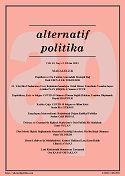LENI RIEFENSTAHL SİNEMASINI TARTIŞMAK
DISCUSSING THE CINEMA OF LENI RIEFENSTAHL
Author(s): Oya Kasap OrtaklanSubject(s): Politics, Gender Studies, Social history, Fascism, Nazism and WW II, Film / Cinema / Cinematography, History of Art
Published by: Rasim Özgür DÖNMEZ
Keywords: Leni Riefenstahl; Fascist Propaganda; Cinema; Feminism; Popular Culture;
Summary/Abstract: Leni Riefenstahl is one of the most controversial figures among the filmmakers of the Nazi era. The films she made during the rule of the NSDAP are a document of collaboration with the Nazi government for some groups and for others pure art. Reviews of her production after the World War II sometimes follow in the footsteps of fascist aesthetics and sometimes reduce her films to images free of ideology. The cinema of Riefenstahl, who all her life rejected the ideological value of her films and tried to defend herself as a director of harmony and beauty, is discussed in this article on the axis of this bipolar discussion. Riefenstahl's name is often remembered with her films Triumph of the Will (1935) and Olympia Parts I and II (1938). From the 1970s on, she was back on the agenda with the photos of the Nuba, an African tribe, and the underwater photos in the following years. The same years marked the beginning of a new era for Riefenstahl in which her past was rehabilitated and she herself experienced a kind of Renaissance. Susan Sontag, who believes in the existence of a connection between Riefenstahl’s aesthetics and images that she created during the Nazi era and before and after this period, is against this rehabilitation process. The idea of “art for art’s sake” and the ethics of showing and seeing come face to face. The article aims to uncover and discuss the structure of fascist propaganda and the periphery it can maintain in liberal society through cinema on the basis of Riefenstahl's films, biography, statements and Sontag's intervention.
Journal: Alternatif Politika
- Issue Year: 13/2021
- Issue No: 3
- Page Range: 790-815
- Page Count: 26
- Language: Turkish

